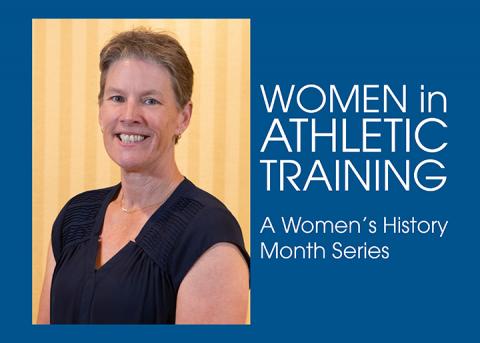
March is an exciting month for athletic trainers. In addition to being National Athletic Training Month, March is also Women’s History Month. This Women’s History Month, we’d like to celebrate all #ATwomen making a difference in the profession and their patients’ lives, and highlight four women in particular who have owned their impact – the four women currently serving on the NATA Board of Directors.
This week, District One Director Diane Sartanowicz, MS, LAT, ATC, shares her journey to athletic training, athletic training inspirations and advice for her fellow athletic trainers.
How did you get involved in the athletic training profession? What was your “ah-ha moment” when you knew you were being called to the profession?
Like many of us, I was interested in the athletic training profession as an athlete in high school. I didn’t have access to an AT, but had a kind and caring coach who also taught anatomy and physiology. I tried to combine my love of sports with my favorite subjects to pursue a career in sports medicine. I knew I wanted to be an athletic trainer when I had the opportunity to meet and interact with some of the best in the profession – legends such as William “Doc” Linskey and Kerkor “Koko” Kassabian. They cared for the health and well-being of their student athletes, and wanted nothing more than to see them succeed on and off the field.
March is Women’s History Month, can you share with us who your women inspiration(s) are? Any women in the athletic training profession?
My inspiration has always been my mom (and dad) and grandmother. My parents were both teachers, and I saw firsthand the love they had for education. I always knew I wanted to follow in their footsteps and become a teacher. My Nana lived with us and was like a third parent. She taught me humor and tenacity, providing support with just the right amount of toughness mixed in. I’m forever grateful for the love and care she gave me growing up.
I have had the good fortune to be inspired by several women athletic trainers. In my district, I’ve gotten to learn from Marjorie King, PhD, ATC, PT, Kathleen Laquale, PhD, ATC, LDN, and Marcia Anderson, PhD, AT Ret. Due to my involvement at the district and national level, I’ve had the pleasure of meeting amazing women such as Marjorie Albohm, MS, AT Ret., Kathy Dieringer, EdD, ATC, LAT, and my fellow “board sisters.” I’m honored to be able to call them colleagues and friends, and continue to learn from them whenever there is opportunity!
How has the profession changed for women in athletic training since you started?
There are more doors open for women in the athletic training profession. We are now seeing growth for women as head athletic trainers in the collegiate and university settings, on professional sports teams as well as in the industrial and occupational settings. The profession is learning how to provide a work-life balance for not only women, but men as well. It truly is a great time to be an athletic trainer!
In 1996, the NATA membership was 44 percent female. The most recent stats have come out and it’s now reversed, where it’s now 56 percent female and 44 percent male. Why do you think that is?
I don’t think this statistic is only applicable to athletic training. Girls are being raised to believe they can do and be anything they want. There are opportunities available today that either weren’t there before or were not as accessible as they are today. Girls can do anything! When it comes to the job market, I believe employers are hiring the best and the brightest for their patients, regardless of gender.
Any advice for females just starting in the profession or are considering becoming an athletic trainer?
Make the most of every opportunity you are given! Don’t be afraid to ask questions. Get involved and stay involved whether at your work setting or state association. I hope you will find what I see in this profession: kind, caring, compassionate individuals who give of themselves for the sake of the well-being of their patients.
What are some ways any athletic trainer can be a gender equality champion?
It takes all of us to stand up for equal rights and to collectively reject any discrimination. The athletic training profession is one of inclusion from a diverse group of individuals. We need to continue to advocate for ourselves and our patients no matter the age, gender, race, religion or disability. There are several educational resources by the NATA LGBTQ+ Advisory Committee that address topics and concerns relevant to diverse sexualities, gender identities and gender expressions within the profession as well as health care topics affecting our patients. Also, let kindness be a guide.
We want to hear from you! Share your #ATwomen inspiration on social media this #WomensHistoryMonth. Don’t forget to also share how you’re owning your #ATimpact.





